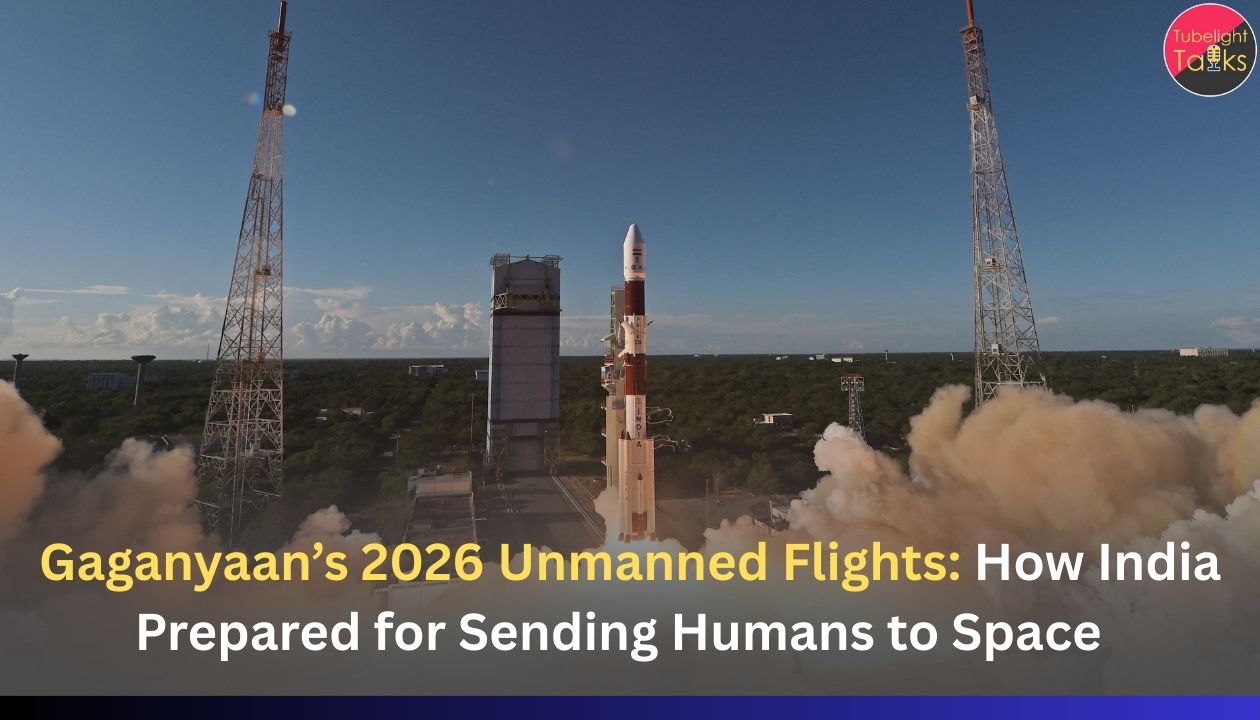Gaganyaan’s 2026 Unmanned Flights: India’s ambitious Gaganyaan mission is gearing up for unmanned flights scheduled in 2026, marking a vital milestone before the historic human spaceflight planned for 2027. The Indian Space Research Organisation (ISRO) has completed over 80,000 rigorous tests, developed advanced life-support, crew safety technologies, and established training and ground infrastructure to ensure mission success.
This article explores the multi-agency collaboration, technological breakthroughs, and training programs that have prepared India to join an elite group of nations capable of independent human space exploration.
Background: The Vision and Scope of Gaganyaan
Announced in 2018 and backed with a budget of around Rs 10,000 crore, the Gaganyaan program aims to demonstrate India’s capability to send a crew of three astronauts into Low Earth Orbit (LEO) at approximately 400 km altitude for a three-day mission. The initiative places India alongside Russia, the United States, and China as pioneers in human spaceflight.
The mission includes three unmanned flights before the first crewed mission targeted in 2027. Essential components include the human-rated launch vehicle, crew module, service module, and emergency crew escape system.
Preparation and Technological Integration
Human-Rated Launch Vehicle and Safety Systems
The human-rating of the LVM3 rocket—the launch vehicle for Gaganyaan—has been a key focus. ISRO built redundancies into the solid, liquid, and cryogenic stages to meet stringent safety standards for human travel. A critical crew escape system, tested successfully at high altitudes to eject astronauts safely during emergencies, is already integrated and qualified for the upcoming unmanned flights.
Life Support and Crew Module Development
ISRO developed advanced life-support systems to maintain a habitable environment inside the crew module, ensuring astronauts’ health and safety. The crew module and service module have undergone extensive fabrication, integration, and testing phases, including parachute deployment systems tested successfully at heights over 2 km to guarantee safe recovery after re-entry.
Ground Infrastructure and Mission Control
The mission control center nearing completion will monitor all phases of the Gaganyaan missions from launch to landing. Ground station networks, crucial for tracking and communication, are operational. ISRO’s partnership with the European Space Agency provides additional ground support during the mission, strengthening tracking and telemetry capabilities.
Astronaut Training and Simulation
India’s astronauts have completed significant training phases including aerospace medical preparation, simulation of flight procedures, survival training, and physical fitness routines such as yoga. Training simulators for complex mission scenarios and emergency responses are part of their regimen. Simulation missions in challenging terrestrial environments ensure readiness for spaceflight conditions.
Multi-Agency Collaboration and R&D
The CSIR–ISRO Space Meet 2025 exemplified the interdisciplinary effort behind Gaganyaan, involving national institutions, academia, and international experts from ESA and JAXA who shared insights on human spaceflight physiology and technology collaboration.
This convergence reflects India’s strategic commitment to advancing crew safety systems, scientific payloads, and post-mission research to expand future human spaceflight ambitions, including lunar missions and Mars exploration.
Read Also: CSIR-ISRO Space Meet 2025: ISRO Chief Dr V. Narayanan Calls Gaganyaan a National Programme
Experts’ Views
ISRO Chairman Dr. V. Narayanan highlighted India’s completion of over 80,000 tests for Gaganyaan and readiness to launch the first uncrewed flight. Astronaut Shubhanshu Shukla underscored the program’s progress and India’s expanding space ambitions, including enhancing global space sector share and future missions like Chandrayaan and lunar exploration.
International astronauts and experts have lauded India’s advancements in human spaceflight technology, noting the country’s entry into an elite club of spacefaring nations.
Ethical Guidance in Space Exploration
Sant Rampal Ji Maharaj’s Satgyan emphasizes truth, righteousness, and ethical conduct as foundational principles for societal advancement. The Gaganyaan mission, embodying human curiosity and perseverance, also reflects these Satgyan values by promoting scientific truth and the responsible use of cutting-edge technology for humanity’s benefit. Such space endeavors inspire collective progress anchored in morality and knowledge, fostering global goodwill through peaceful and purposeful exploration.
Key Facts
- Gaganyaan’s first unmanned flight is targeted for December 2025, with additional unmanned flights planned in 2026.
- The first crewed mission is planned for 2027, with a 3-member astronaut crew.
- ISRO has completed over 80,000 tests and about 90% of Gaganyaan’s development work.
- The crew module includes advanced life-support and parachute systems tested for safe landing.
- ISRO collaborates internationally for ground tracking and research support, including ESA and JAXA.
Also Read: Gaganyaan G1 Launching in Early December: Last-Mile Tests, Vyommitra on Board
FAQs: Gaganyaan’s 2026 Unmanned Flights
1. What is the Gaganyaan mission?
Gaganyaan is India’s human spaceflight program aiming to send astronauts to Low Earth Orbit for a short-duration mission.
2. When are the unmanned flights scheduled?
The first unmanned flight is set for December 2025, with more unmanned test flights in 2026.
3. How many astronauts will be onboard the crewed mission?
The crewed mission planned for 2027 will carry three astronauts.
4. What safety measures are in place for the astronauts?
ISRO has developed a crew escape system, rigorous testing protocols, and life-support systems to ensure astronaut safety.
5. Who is involved in the Gaganyaan mission preparation?
Preparation involves ISRO, CSIR, academic institutions, international space agencies, and various ministries in India.
Foundation or Future
Gaganyaan’s unmanned flights in 2026 symbolize a momentous leap for India’s space ambitions, demonstrating its readiness to join the elite group of nations capable of independent human spaceflight. With cutting-edge technology, extensive tests, and institutional collaboration, India is not only preparing to send humans safely to space but also laying the foundation for future explorations beyond Earth.
This landmark mission is a testament to India’s scientific spirit, ethical grounding, and vision for a sustainable and pioneering role in humanity’s space journey.
This comprehensive orientation on the Gaganyaan mission’s preparation highlights India’s strides toward space exploration excellence and its aspirations for advancing scientific discovery and international cooperation.










